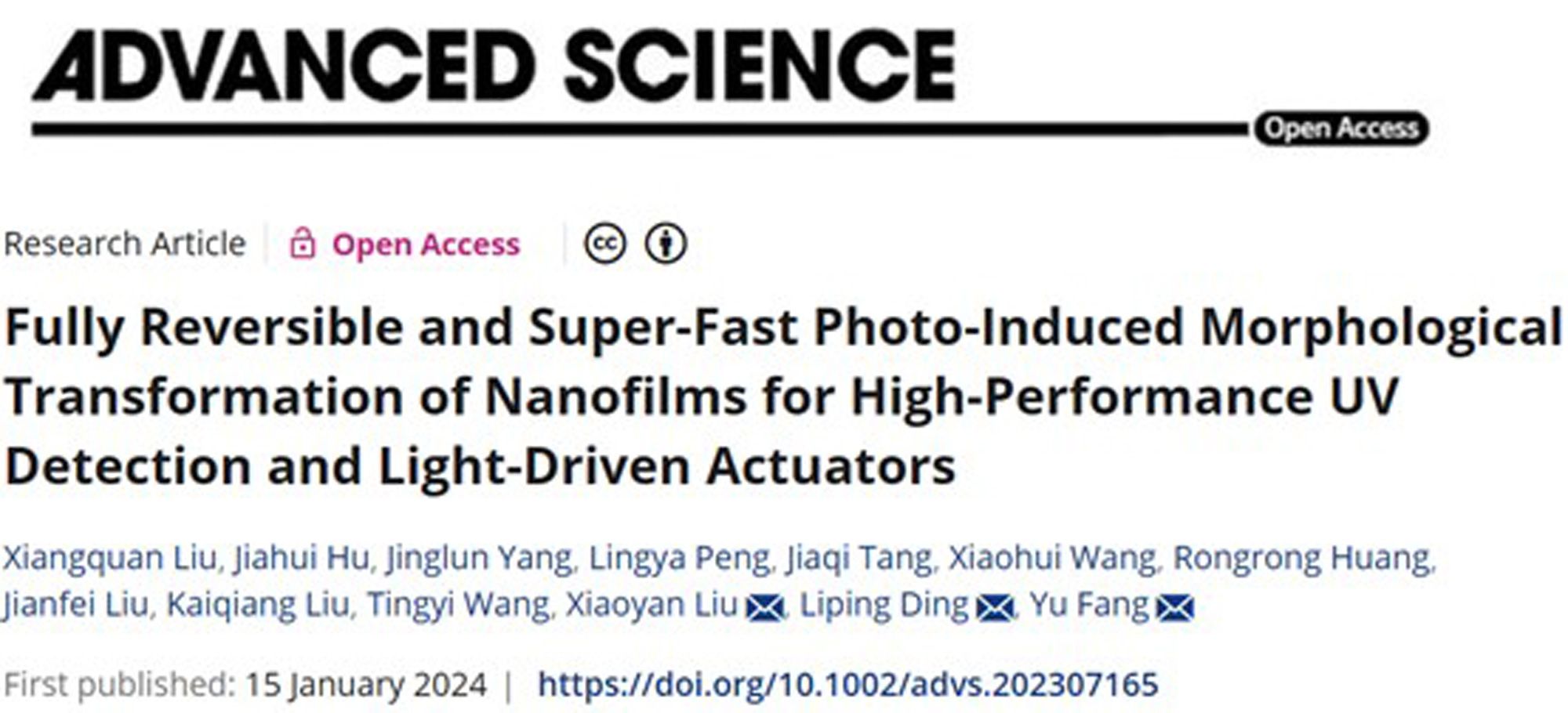
Xiangquan Liu, Jiahui Hu, Jinglun Yang, Lingya Peng, Jiaqi Tang, Xiaohui Wang, Rongrong Huang, Jianfei Liu, Kaiqiang Liu, Tingyi Wang, Xiaoyan Liu*, Liping Ding*, and Yu Fang*. Adv. Sci., 2024, 11, 2307165.
UV light is widely utilized in both military and civilian applications. However, the rigid inorganic semiconductors and halide perovskites have limited flexibility and difficulties in machining, which make them be not suitable to develop flexible products. Recently, photo-deformable materials have garnered considerable attention across various areas, such as energy harvesting, soft robotics, artificial muscles, and switchable devices. Herein, a type of nanofilms with unprecedented fully reversible UV responsiveness are successfully constructed. Building upon this discovery, a new system for ultra-fast, sensitive, and reliable UV detection is developed. The system operates by monitoring the displacement of photoinduced macroscopic motions of the nanofilms based composite membranes. The system exhibits exceptional responsiveness to UV light at 375 nm, achieving remarkable response and recovery times of < 0.3 s. Furthermore, it boasts a wide detection range from 2.85 µW cm−2 to 8.30 mW cm−2, along with robust durability. Qualitative UV sensing is accomplished by observing the shape changes of the composite membranes. Moreover, the composite membrane can serve as sunlight-responsive actuators for artificial flowers and smart switches in practical scenarios. The photo-induced motion is ascribed to the cis–trans isomerization of the acylhydrazone bonds, and the rapid and fully reversible shape transformation is supposed to be a synergistic result of the instability of the cis-isomers acylhydrazone bonds and the rebounding property of the networked nanofilms.

Figure 1. Schematic representation of the preparation of an unique nanofilm and its application in UV detection.
The composite membranes can also be used for visualized sensing of UV light. A fluorescent display system was constructed to show different fluorescent patterns under different UV intensity. Furthermore, a smart switch was created by coating a thin gold film on both sides of the composite membrane. When illuminated by UV light, the membrane bent downward, resulting in the activation of a light-emitting diode (LED) due to the completion of the electric circuit. Removal of UV light turned off the LED. The fabrication of a highly sensitive and super-fast UV-responsive artificial flower was designed to monitor UV light intensity at different times of the day. Another smart UV light-responsive switch was developed, enabling the automatic opening and closing of a curtain by controlling the motor's forward and reverse rotation.

Figure 2. The CPTH-TFPA/PET composite membrane act as a visual sensor of UV light and a smart switch in practical scenarios.
In summary, we have successfully created a high-performance UV detector based on the fast, robust, and fully reversible UV-responsive nanofilms. Importantly, the detection wavelength of the UV light can be largely adjusted by modifying the structure of the photo-responsive building block of the nanofilms. Furthermore, we have successfully achieved visual detection of UV light, enabling on-site, real time and power free sensing. Moreover, the composite membrane can serve as sunlight-responsive smart actuators for practical applications. The innovative CPTH-TFPA/PET membrane and our sensing model provide new opportunities for flexible organic materials to achieve fast, sensitive, and stable UV detection.
First Author: Liu Xiangquan, doctoral candidate, Shaanxi Normal University
Correspondence Authors: Prof. Fang Yu, Prof. Ding Liping, Assoc. Prof. Liu Xiaoyan, Shaanxi Normal University
Full Text Link: https://doi.org/10.1002/advs.202307165